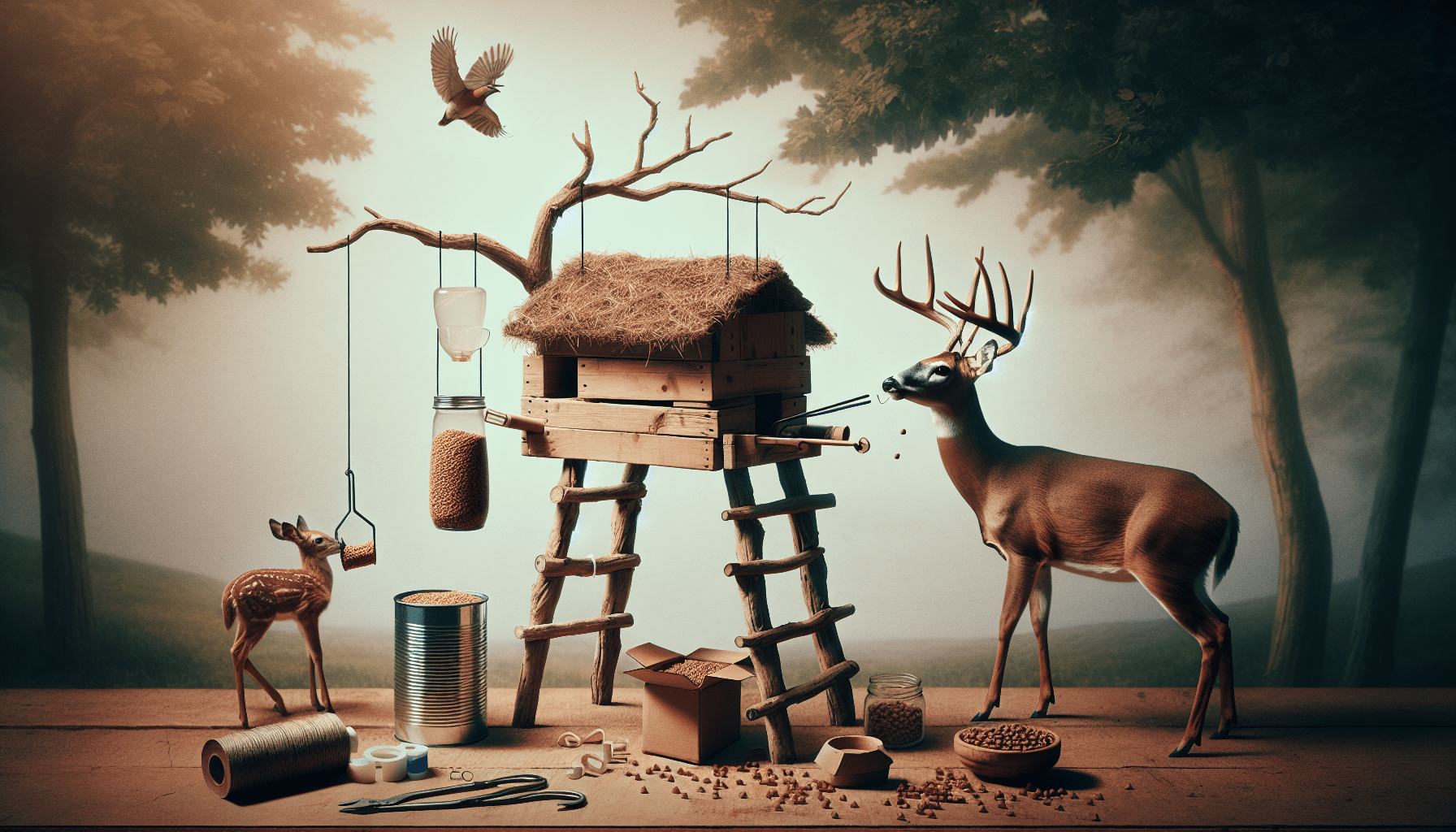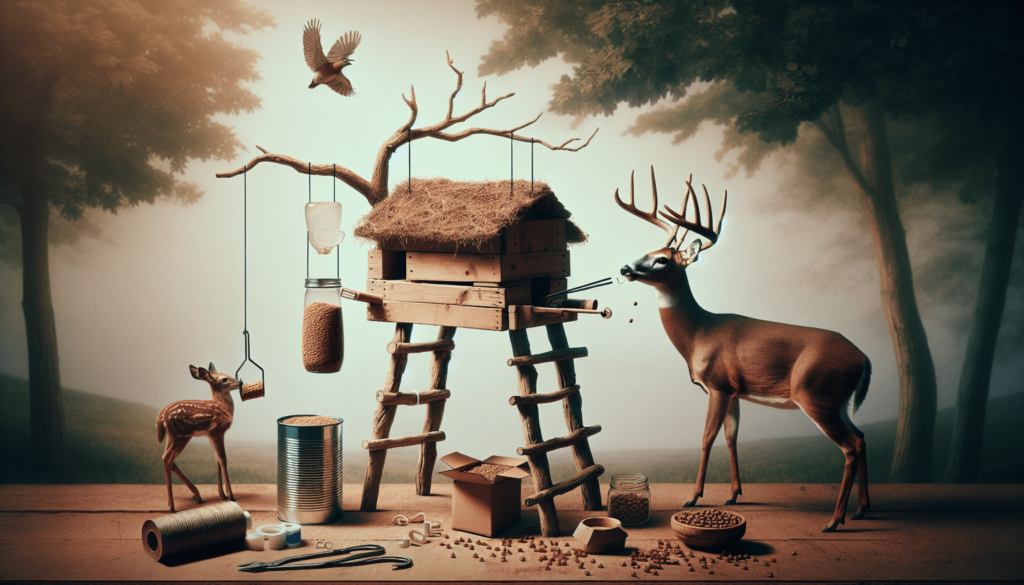
Looking to attract deer to your property and provide them with a reliable food source? Look no further! Our step-by-step guide will walk you through the process of building a gravity deer feeder using simple household items. With just a few materials and some basic tools, you can create a cost-effective and efficient feeder that will keep those hungry deer coming back for more. Whether you’re a seasoned DIY enthusiast or just starting out, this guide is perfect for anyone looking to enhance their wildlife-watching experience. So, roll up your sleeves and get ready to embark on an exciting project that will bring joy and beauty to your backyard. Let’s get started!

Understanding A Gravity Deer Feeder
What is a gravity deer feeder
A gravity deer feeder is a simple and effective device used to attract and feed deer in your backyard or hunting property. It operates on the principle of gravity, allowing the deer to access the feed whenever they need it. Unlike other types of deer feeders, gravity feeders do not require any additional power source or complicated mechanisms. They are designed to provide a continuous supply of feed to the deer, ensuring they are well-fed and healthy.
Benefits of using a gravity deer feeder
Using a gravity deer feeder has several benefits for both the deer and the feeder. Firstly, it helps attract deer to a specific location, making it easier for hunters to observe and hunt them. Additionally, it provides a consistent and reliable food source for deer, especially during times when natural forage may be scarce. This can help supplement their diet and improve their overall health. Gravity deer feeders also require minimal maintenance and are relatively inexpensive compared to other feeder options. They are easy to build using household items, making them accessible to anyone interested in attracting deer to their property.
Gathering The Necessary Materials
Materials found around your home
To build a gravity deer feeder, you can gather most of the necessary materials from items found around your home. Some common materials you may already have include:
- A 1-gallon plastic bucket
- A wooden dowel or thick stick
- Nails or screws
- Adhesive (such as epoxy or strong glue)
- A drill with various drill bits
- A saw (if needed for cutting wood or PVC pipes)
- Wire or rope for hanging the feeder
- Deer feed
Additional materials needed if unavailable at home
If you do not have certain materials available at home, you may need to purchase them from a local hardware or home improvement store. Some additional materials you may need include:
- Metal washers or nuts (for reinforcement)
- PVC pipes and fittings (for spouts or additional support)
- Carabiners or hooks (for hanging the feeder)
- Animal-proof lids or cages (to protect the feed from other animals)
Before starting the construction process, make sure you have all the necessary materials on hand to ensure a smooth and uninterrupted building process.
Selecting An Ideal Location For The Feeder
Choosing a location in your backyard
When selecting a location for your gravity deer feeder, it is important to consider a few key factors. Firstly, choose an area in your backyard that is easily accessible for you to monitor and maintain the feeder. Consider the proximity to your house or hunting blind, as well as the visibility from those areas.
Considerations for choosing deer feeder location
In addition to accessibility, there are a few other considerations to keep in mind when choosing the location for your feeder. Deer are cautious and skittish animals, so it is best to place the feeder in a peaceful and secluded area away from excessive human activity. Look for areas with natural cover or vegetation where deer are likely to feel safe while feeding.
Another important consideration is the proximity to a water source. Deer require water regularly, especially when consuming dry feed. Placing the feeder near a natural water source or providing a separate water station can enhance the attractiveness of your feeder to deer.
Remember to check your local regulations or consult with local hunting authorities to make sure you are compliant with any restrictions on feeder placement in your area.
Creating A Basic Design for the Deer Feeder
Elements of a successful design
A successful gravity deer feeder design consists of several key elements. Firstly, the feeder should be sturdy and secure to withstand the weight of deer and any environmental conditions. It should also be easy to fill and maintain, ensuring that you can regularly provide fresh feed for the deer. Additionally, the design should incorporate spouts or openings that allow the deer to access the feed while preventing other animals from reaching it.
Drawing out your design before construction begins
Before you start constructing the feeder, it can be helpful to draw out your design on paper. This will allow you to visualize the different components and ensure that you have considered all the necessary elements. Consider the dimensions, placement of spouts, and any additional features you may want to incorporate. Having a clear plan will make the construction process smoother and more efficient.
Building The Feeder’s Main Body
Repurposing a gallon bucket as the feeder’s body
To build the main body of the gravity deer feeder, you can repurpose a 1-gallon plastic bucket. Start by cleaning and sanitizing the bucket to remove any chemicals or residue. This will ensure the feed remains safe and uncontaminated for the deer. Choose a bucket with a sturdy handle that can support the weight of the feeder when filled.
Drilling holes for the feeding spouts
using a drill with the appropriate drill bits, drill holes near the bottom of the bucket to create the feeding spouts. The size and number of holes will depend on the desired feeding capacity and the type of feed you plan to use. For larger pellets or grains, larger holes may be necessary, while smaller holes are suitable for smaller feeds. Space the holes evenly around the bucket to provide easy access for multiple deer at the same time.
Constructing The Feeding Spouts
Optimal size and number of spouts
When constructing the feeding spouts, it is important to consider the optimal size and number based on your specific needs. The size of the spouts should be large enough for the feed to flow smoothly but small enough to prevent excessive spillage or waste. Similarly, the number of spouts should align with the expected number of deer visiting the feeder. Having multiple spouts can accommodate more deer and reduce competition during feeding.
Ensuring smooth grain flow
To ensure a smooth flow of the grain through the spouts, it is essential to smoothen any rough edges or burrs created during the drilling process. You can use sandpaper or a file to gently remove any sharp or rough edges that may hinder the free flow of the feed. This will help prevent blockages and ensure the deer can access the feed easily.
Attaching The Spouts To The Main Body
Securely attaching spouts using adhesive or screws
Once the spouts have been constructed, they can be securely attached to the main body of the feeder. This can be done using strong adhesive, such as epoxy or glue, or by using screws or nails for added durability. Ensure that the spouts are firmly attached and sealed to prevent any feed from leaking out. Reinforce the attachment points with metal washers or nuts if needed to provide extra strength and stability.
Choosing the right position for your spouts
Consider the positioning of the spouts carefully to ensure they are located at a height that is accessible to the deer. Placing them too high may make it difficult for smaller or younger deer to reach, while positioning them too low may allow other animals to access the feed. Aim for a height that is comfortable for deer to feed from, keeping in mind their average shoulder height.
Mounting Your Deer Feeder
Making a sturdy base for the feeder
To mount your gravity deer feeder, you will need a sturdy base or support structure. A common method is to attach a wooden dowel or thick stick to the bottom of the bucket to provide stability and elevation. Dig a hole and securely place the dowel or stick into the ground, ensuring it is firmly anchored. Alternatively, you can use PVC pipes and fittings to construct a more elaborate base if desired.
Hanging the feeder in an elevated position
Another popular mounting option is to hang the feeder from a tree branch or elevated structure. This provides additional security and helps protect the feed from other animals. Attach wire or rope to the handle of the bucket and securely fasten it to the chosen hanging point. Make sure the feeder is at a sufficient height to prevent easy access to the feed by other animals, such as raccoons or squirrels.
Filling The Gravity Deer Feeder
Choosing the right feed for deer
When filling your gravity deer feeder, it is important to select a feed that is appropriate for deer and their nutritional needs. Opt for commercial deer feed or a mix specifically formulated for deer. Avoid using human food or other types of feed that may be harmful or insufficient for deer. It is recommended to consult with a local hunting or wildlife expert to determine the most suitable feed for the deer species in your area.
Optimal filling amounts
The amount of feed you should fill in your deer feeder will largely depend on the frequency of deer visits and the size of the feeder. It is generally recommended to fill the feeder half to two-thirds full to ensure a continuous supply of feed without excessive wastage or spoilage. Monitor the consumption rate and adjust the filling amount accordingly to maintain a consistent feeding schedule for the deer.
Maintaining Your Homemade Deer Feeder
Regular cleaning
To ensure the longevity and effectiveness of your homemade deer feeder, it is essential to establish a regular cleaning routine. Remove any leftover feed or debris from the feeder periodically to prevent the accumulation of mold or bacteria. Clean the feeder with warm soapy water and rinse thoroughly before refilling. Consider using a mild disinfectant to sanitize the feeder, especially during times of heightened disease or infection risks.
Refilling schedule
Establish a regular refilling schedule based on the deer activity and consumption rate. Monitor the feed levels in the feeder and replenish as needed to ensure a constant food supply. It is crucial to regularly check and refill the feeder, particularly during critical periods such as winter when natural food sources may be scarce. Adjust the refill frequency based on the seasonal availability of forage and the number of deer visiting the feeder.
Periodically checking for wear and tear
Over time, the homemade deer feeder may experience wear and tear due to weather conditions and constant use. Periodically inspect the feeder for any signs of damage or weakening. Check the attachment points of the spouts, the overall stability of the feeder, and the condition of the hanging or supporting structure. Make any necessary repairs or replacements to maintain the feeder’s functionality and safety.
By following these steps and guidelines, you can successfully build and maintain a gravity deer feeder using household items. Remember to always prioritize the well-being of the deer and ensure compliance with local hunting regulations. Enjoy the rewards of attracting and supporting deer in your backyard or hunting property through the use of a gravity deer feeder. Happy feeding!



